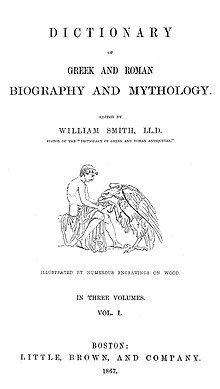|
Dictionary of Greek and Roman Biography and Mythology
The Dictionary of Greek and Roman Biography and Mythology is a biographical dictionary of classical antiquity, edited by William Smith and originally published in London by Taylor, Walton (and Maberly) and John Murray from 1844 to 1849 in three volumes of more than 3,700 pages. It is a classic work of 19th-century lexicography. The work is a companion to Smith's Dictionary of Greek and Roman Antiquities and Dictionary of Greek and Roman Geography.[1] Authors and scope The work lists thirty-five authors in addition to the editor, who was also the author of the unsigned articles. The other authors were classical scholars, primarily from Oxford, Cambridge, Rugby School, and the University of Bonn, but some were from other institutions. Many of the mythological entries were the work of the German expatriate Leonhard Schmitz, who helped to popularise German classical scholarship in Britain.[2] With respect to biographies, Smith intended to be comprehensive. In the preface, he writes:
Much of the value of the Dictionary consists not only in the depth and detail of the individual articles, but in the copious and specific citations to individual Greek and Roman writers, as well as modern scholarship from the Renaissance to the mid-nineteenth century. The articles frequently note variant traditions, disagreements among the authorities, and the interpretations of modern scholars. However, due to the variable numbering systems used in different editions of classical works, and the difficulty of recognizing typographical errors in citations, the original sources should still be checked. Many of the Dictionary's articles have been referred to in more recent works; Robert Graves has been accused of cribbing his impressive-looking source references from it when writing The Greek Myths.[3] Samuel Sharpe thought Edward Bunbury had plagiarised his work, as he wrote of in his diary entry on 3 September 1850:
Notable authors
Use and availability todayThe work is now in the public domain, and is available in several places on the Internet. A 2013 review of the fourth edition of the Oxford Classical Dictionary – itself hailed in its first edition in 1949 as "the new Smith"[5] – called it:
Smith's dictionary, however, does have substantial flaws. Troy and Knossos, for example, "the editors still regarded... as minstrels' fantasies".[7] Much is missing, especially more recent discoveries (such as Aristotle's Constitution of the Athenians or the decipherment of Linear B) and epigraphic material. More seriously, the context in which ancient evidence is viewed, analysed, reconciled, and understood has changed considerably in the intervening centuries. Modern theories and reconstructions of events are also not present, if only because they were published decades and centuries after Smith's Dictionary. See alsoReferencesCitations
Sources
External linksWikimedia Commons has media related to The Dictionary of Greek and Roman Biography and Mythology. Wikisource has original text related to this article:
Also the Internet Archive has a derivative work:
|
||||||||||
